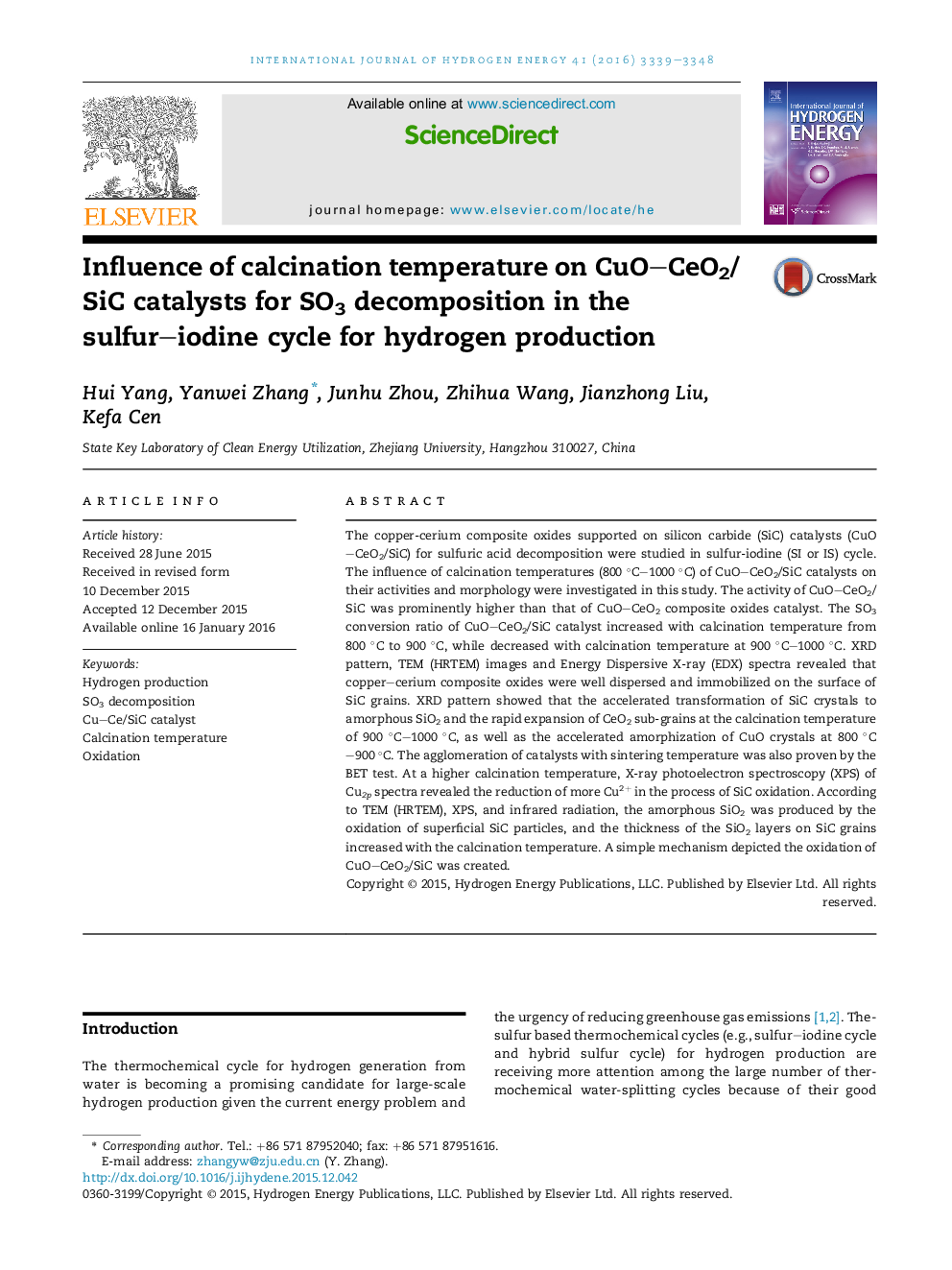| Article ID | Journal | Published Year | Pages | File Type |
|---|---|---|---|---|
| 1270239 | International Journal of Hydrogen Energy | 2016 | 10 Pages |
•The effects of calcination temperatures on CuO–CeO2/SiC were firstly introduced.•The activity and stability of catalyst were validated in low temperature range.•Effects of calcination temperature were characterized by methods.•An oxidation mechanism of CuO–CeO2/SiC catalyst was presented.
The copper-cerium composite oxides supported on silicon carbide (SiC) catalysts (CuO–CeO2/SiC) for sulfuric acid decomposition were studied in sulfur-iodine (SI or IS) cycle. The influence of calcination temperatures (800 °C–1000 °C) of CuO–CeO2/SiC catalysts on their activities and morphology were investigated in this study. The activity of CuO–CeO2/SiC was prominently higher than that of CuO–CeO2 composite oxides catalyst. The SO3 conversion ratio of CuO–CeO2/SiC catalyst increased with calcination temperature from 800 °C to 900 °C, while decreased with calcination temperature at 900 °C–1000 °C. XRD pattern, TEM (HRTEM) images and Energy Dispersive X-ray (EDX) spectra revealed that copper–cerium composite oxides were well dispersed and immobilized on the surface of SiC grains. XRD pattern showed that the accelerated transformation of SiC crystals to amorphous SiO2 and the rapid expansion of CeO2 sub-grains at the calcination temperature of 900 °C–1000 °C, as well as the accelerated amorphization of CuO crystals at 800 °C–900 °C. The agglomeration of catalysts with sintering temperature was also proven by the BET test. At a higher calcination temperature, X-ray photoelectron spectroscopy (XPS) of Cu2p spectra revealed the reduction of more Cu2+ in the process of SiC oxidation. According to TEM (HRTEM), XPS, and infrared radiation, the amorphous SiO2 was produced by the oxidation of superficial SiC particles, and the thickness of the SiO2 layers on SiC grains increased with the calcination temperature. A simple mechanism depicted the oxidation of CuO–CeO2/SiC was created.
Graphical abstractBased on the above characterization, an oxidation mechanism of SiC particle was proposed at 800 °C–1000 °C. As shown in Fig. 9, the thickness of the SiO2 layer and the size of the CuO–CeO2 composite oxides particles on the surface of the SiC particle increased prominently with the temperature. According to the XRD and HRTEM, the majority of the SiC grain were transformed into amorphous SiO2 at 1000 °C. As shown on the top of Fig. 9, the higher calcination temperature promoted the agglomeration of the adjacent CuO–CeO2 composite oxide particles, and the increased amorphous SiO2 covered parts of the small particles. At 1000 °C, parts of the CuO–CeO2 oxides were covered by amorphous SiO2, thus hindering the catalytic SO3 decomposition on the CuO–CeO2 composite oxides.The oxygen was adsorbed on the outmost SiC layer, and the adsorbed oxygen relaxed into the Si–C bonds to form a Si–O–C layer . The Si–O–C layer was unstable against O2 corrosion, and a SiO2 layer (detected by the XPS spectra and XRD) on SiC was formed . When the amount of C reached a certain value, the produced C led to the partial reduction of the CuO–CeO2 composite oxides. The SiC particle was covered by a preformed SiO2 layer that hindered the diffusion of O and C. The higher the temperature it was, the higher the energy of O and C atoms. As shown at the bottom of Fig. 9, the more active O (with higher energy) diffused deeper into the SiC particle, and the replaced C atom at the interface of the SiC and SiO2 layers diffused out. The calcination temperature showed a clear correlation with the SiO2 thickness, as revealed by HRTEM.Figure optionsDownload full-size imageDownload as PowerPoint slide
